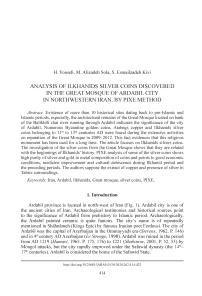Analysis of Ilkhanids silver coins discovered in the great mosque of Ardabil city in northwestern Iran, by PIXE method
Автор: Yousefi H., Alizadeh Sola M., Esmailzadeh Kivi S.
Журнал: Краткие сообщения Института археологии @ksia-iaran
Рубрика: Естественнонаучные методы в археологических исследованиях. Изучение состава древнего металла
Статья в выпуске: 262, 2021 года.
Бесплатный доступ
Existence of more than 10 historical sites dating back to pre-Islamic and Islamic periods, especially, the architectural remains of the Great Mosque located on bank of the Balikhlli chai river running through Ardabil indicates the significance of the city of Ardabil. Numerous Byzantine golden coins, Atabegs copper and Ilkhanids silver coins belonging to 11th to 13th centuries AD were found during the extensive activities on reparation of the Great Mosque in 2009-2012. This fact evidences that this religious monument has been used for a long time. The article focuses on Ilkhanids silvers coins. The investigation of the silver coins from the Great Mosque shows that they are related with the beginnings of Ilkhanids' history. PIXE analysis of some of the silver coins shows high purity of silver and gold in metal composition of coins and points to good economic conditions, medicine improvement and cultural dehiscence during Ilkhanid period and the preceding periods. The authors suppose the extract of copper and presence of silver in Tabriz surroundings.
Iran, ardabil, ilkhanids, great mosque, silver coins, pixe
Короткий адрес: https://sciup.org/143176019
IDR: 143176019 | DOI: 10.25681/IARAS.0130-2620.262.414-422
Текст научной статьи Analysis of Ilkhanids silver coins discovered in the great mosque of Ardabil city in northwestern Iran, by PIXE method
Ardabil province is located in north-west of Iran (Fig. 1). Ardabil city is one of the ancient cities of Iran. Archaeological testimonies and historical sources point to the significance of Ardabil from prehistory to Islamic period. Archaeologically, the Ardabil painted ceramic is quite famous. The city’s name is of repeatedly mentioned in Shāhnāmeh (Kings Epic) by famous Iranian poet Ferdousi. The city of Ardabil was the capital of Azerbaijan in the Ommayyads era ( Stevens , 1962. P. 146) and in 4th century AD Azerbaijan ( Le Strenge , 1998). Ardabil was ruined in the period from AD 1219 ( Hamavi , 1965. P. 175, 176) to 1221 ( Shabarow , 2001. P. 52, 53) by Mongol attacks, but the city rapidly improved under the Safawid dynasty (the 14th– 17th centuries). Ardabil is considered the home of the Safawid State.
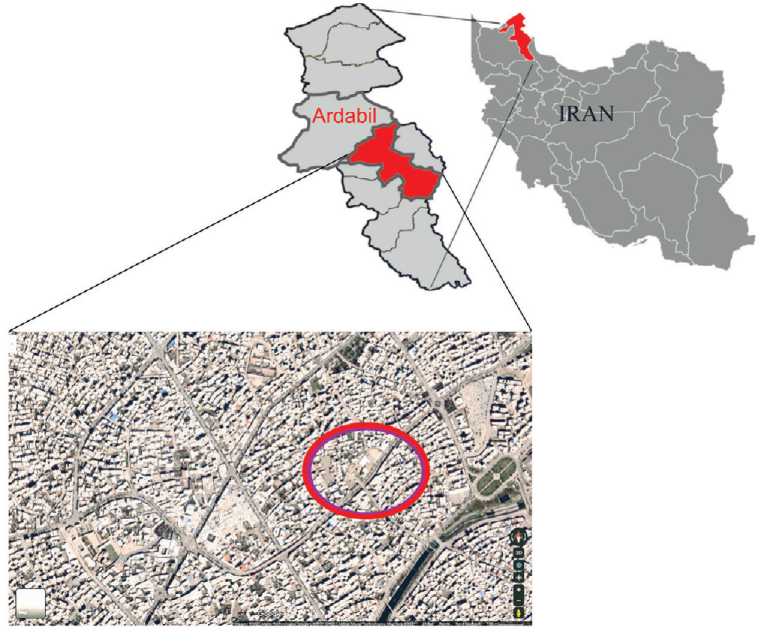
One of Iran’s early great mosques was setup in Ardabil city. The Ardabil mosque has been built in eastern north of historical part of the city on the site elevated about 5 meters over the surrounding grounds ( Siroux , 1941. P. 89, 90) on the highest point of the tell ( Mousavi , 2003). The mosque is located at 38° 15´05 67˝ northern latitude, 48° 18´12 64˝ longitude, and at altitude of 1351 above sea level in the center of the city of Ardabil (Fig. 2). The Ardabil Great mosque was mentioned for the first time by the famous Arab historian Fotuoh al-Boldan ( Belazory ,1985).
The architectural remains of the mosque include a domed hall, rectangular Iwan, the courtyard of a mosque, minaret and numerous brick pillars in southern, eastern, and northern directions uncovered during archeological investigations. Some researchers mentioned the history of the mosque and its rebuilding between 1204 and 1279. The discoverer of the site of the Great mosque has dated it to 12th and 13th centuries, not providing an exact building date ( Ṣafari , 1992. P. 180, 181). while the mosque main core, several porches around the central courtyard are similar to Shabestān mosques of the 3rd and 4th centuries AD.
Architectural ornamental elements and some findings obtained by archeological studies are important for the chronology of the mosque. Comparative studies have
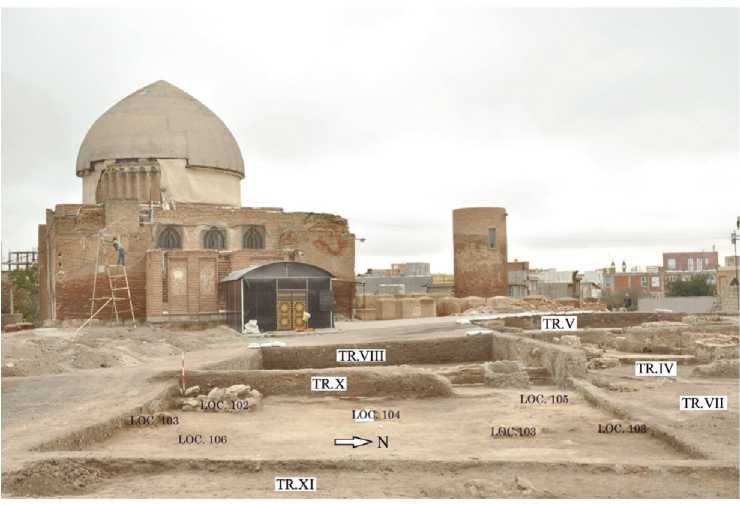
Fig. 2. The Great mosque of Ardabil attributed many decorative elements to the time span of Buwayhids dynasty to Qājār period. The stamped motifs of brick bound, ornamental and cornice bed molding together with existent drawings, support the above mentioned date. New finds obtained during the mosque repair works in two recent years are important for suggesting a more exact chronology of the mosque. Among them there are twenty five Byzantine golden coins and numerous copper coins of Atabegs Ildenizids, known as Atabegs of Azerbaijan era found on the floor of Shabestāns in northern and western sides, and silver coins of Ilkhanid era. These data suggest that this era was the prime of Ardabil history and its mosque.
2. Discussion
The Great mosque of Ardabil is one of the early mosques in Iran. It covers cultural phases related to pre-Islamic and Islamic periods, therefore it is of importance for studying these chronological periods. Discovery of golden coins of Byzantine origin and silver and copper coins belonging the periods from Atabegs to Qājārtimes in historical context of the Great mosque of Ardabil is an important archeological success. When discovered, silver coins found in the Ardabil mosque were placed in a worn cloth bag; a part of the cloth is preserved on one of the coins (Fig. 3). One side of the coins bears the inscription “ لا الھ الا الله محمد رسول الله ” (There is no God except, Mohammad is the prophet of), the inscription on the other
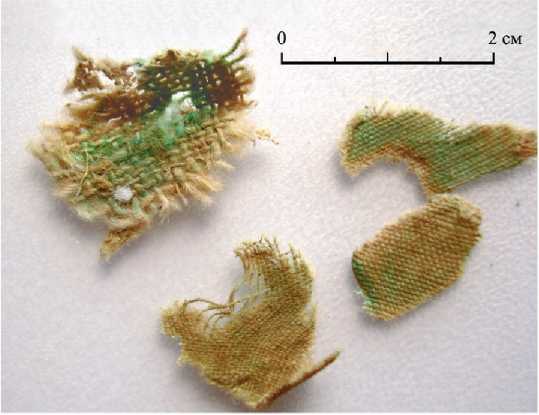
Fig. 3. Remains of cloth bag on the coin
•veeie
I___________________________J 1 1 1____________________I I__________________________J I___________________________J
Fig. 4. Analyzed silver coins from the Great mosque side reads “قاآنالعادل” qāan al-ādel (just ruler). two coins (number 1 and 4) have been minted in Tabriz.
This research focuses on five (of total ten) silver coins discovered on the floor of the main porch in northern part of domed nave (Fig. 4) and the results of their analysis. Analysis of historical coins originating from archeological studies presents valuable information concerning different aspects of social, religious, art, cultural, economic life and process of producing metal in te discussed historical era. The study includes exact identification of elements in metal of coins. The coins study required non-destructive and fast analytical methods. Physical PIXE (Proton induced X-ray emission) non-destructive method has been selected among all routine methods.
Ten silver coins discovered in the mosque of Ardabil belonging to the early Ilkhanid era were analyzed using PIXE method with the aim to study the economic conditions of this period and compare them with earlier periods. In this experiment funny filter was used for analyzing the matrix, and low value elements and GUPIX software was used for analyzing the obtained spectra.
3. Analysis of five silver coins
PIXE is a capable and powerful non-destructive method for analyzing elemental composition of metal. High sensitivity in identification of rare elements in one sample is specific feature of this method. Using this method a short time after discovering and installation of Van de Graaff accelerator has been developed in Iran in the field of archeology in collaboration with archeologists since 1991. The application of this method is based on the effect when atoms can give one of their electrons of internal layers by contraction of proton with atoms of constituent elements of coins. Filling of internal layers of atoms is done by electrons of upper layers due to presence of energy difference of layers by sending X-ray energy. X-ray energy identifies the kind of that element in the samples ( Aqaaligol et al. , 2007. P. 755).
During the analysis procedure, the coins were cleaned with ethanol and placed in experimental chamber. The features of analyzed coins composition are presented in Table 1. Two coins of the five analyzed coins belong to Ilkhanid era (coins number 1 and 2) and three other coins (number 3, 4, 5) are attributed to Abaga khan.
Table 1. Elemental composition of the metal of coins number 1–5
|
Element |
Coin 1 |
Coin 2 |
Coin 3 |
Coin 4 |
Coin 5 |
|
Si |
1,33 |
0,29 |
1,18 |
0,85 |
2,2 |
|
K |
0,24 |
||||
|
Cl |
4,29 |
0,58 |
|||
|
Ca |
7,15 |
1,68 |
|||
|
Cu |
10,85 |
3,32 |
5,33 |
2,2 |
3,49 |
|
Ag |
75,42 |
93,12 |
86,23 |
96,04 |
91,84 |
|
Au |
0,72 |
1,01 |
0,8 |
0,91 |
0,96 |
|
Na |
5,65 |
||||
|
Fe |
0,06 |
0,1 |
|||
|
Zn |
0,5 |
||||
|
As |
0,25 |
0,23 |
|||
|
Al |
1,18 |
The thickness of all coins was the same and their weights varied from 0,8 to 3 g. The biggest size was established on coin number 4 with 2,3 mm in diameter and the smallest diameter was established on coins number 1 and 2, that is 1,3 mm.
Coins number 3 and 5 have been put in a holder with much care to avoid damage. We evacuated the experiment chamber by using rotating pump and diffusion pump to torr 10–5 pressure in order to avoid proton energy loss and weaken X-ray sent from coins. We used proton with 2 MeV energy obtained from AEOI van de Graaff accelerator located in van de Graaff library of energy and atom organization of Iran for bombing coins. We detected X-ray sent from the sample by detector Si (Li) located in 135 degree to proton with resolution power 135 keV for energy 5,9 keV.
The proton makes a contact with the coin surface below 90 degree and we can measure the value of charge by Faraday cap located at the back of the coins. Funny filter was used for removing the brake radiation of secondary electrons and analyzing the matrix and trace elements ( Ben Abdelouahed et al. , 2010. P. 59) in the coins with 174 km µm thickness and a hole with 4 percent of all area of detector surface.
The sent X-ray is collected in detector and forms a spectrum and the obtained spectrum is analyzed by GUPIX Software ( Patra et al. , 2012. P. 613). This software determines the identity of X-ray by using physical parameters with nonlinear practice, and by doing required correctness, computes the density of elements. These parameters include the experiment conditions, detector, experiment chamber, energy of input ingredients, collected pure charge, cross-section of ionization and thickness of the sample. We introduced silver element because of the thickness of the sample as a matrix in this experiment. The relation between determined X-ray for a specific element Y(Z) with atomic number, Z and the thickness of that element Cz in certain matrix as following:
Y(z) = HY1(Z)CzQεztz
In the above equation Y1 (Z) is the number of computed X-ray from data bases in all spatial angle and the unit density, unit charge, Q is charge εz is the natural sensitivity of detector, tz is the value of transmitting rays through filter which was located between detector and sample, H is the constant value of the experiment and depends on spatial angle of detector and collected charge. The relative error of counting the rays which resulted from lack of certainly in measuring the exact value of H and level of counting and determining the exact value of charge for each of five coins for silver element is less than 5 % (tabl. 1).
The values of density of constituent elements of coins are shown in Fig. 5. Twelve elements including Silicon, Potassium, Chlorine, Calcium, Copper, Silver, Gold, Sodium, Iron, Zinc, Arsenic, Aluminum have been identified. As it was expected, silver shows the highest percent among other elements. It is clear from the following chart that the coin which has shown the highest percentage of silver has the lowest content of copper (Fig. 5; 6).
According to the above table, three elements, copper, gold, silver are considered the main elements. Silicon is related to pollution of coin surfaces and the presence of other elements can be considered as the result of pollution of surface or impurity while mintage. But it is preferred that only main metal element inside the coins considered in order to avoid this kind of complexity in determining the density of elements. It is notable that there is no other element except constant elements in coin number 4. The PIXE spectrum of coin number 4 is presented in Fig. 5. As it was expected, only silver element with peaks L, K series are seen in observation of element peaks and other elements are observable with one series. Among main constituent elements of
Count Ag-La

0 1 2 3 4 5 6 7 8 9 10 11 12 13 14 15 16 17 18 19 20 21 22 23 24 25 26 27 28 29
Fig. 5. Charts showing correlation of elements in metal of coins number 1–5
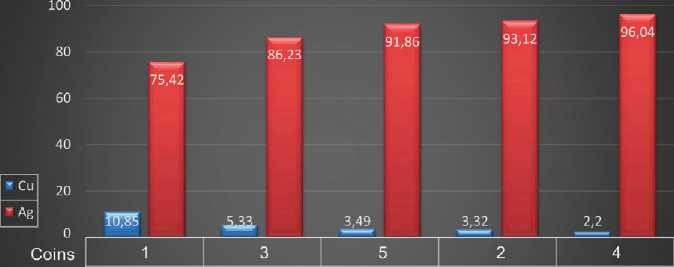
Fig. 6. Silver and copper content in analyzed coins number 1–5
coins, gold has the least density, so that gold varies between 0,72–1,01 percent and silver varies from 75,42 to 96,04 percent (Fig. 6).
These measurements show that all analyzed historical silver coins contain some gold (between 0,5 and 2 percent). The presence of gold in silver coins can be considered as one of the measures of determining the originality of coins.
4. Conclusions
We observe that the coins with high percentage and purity of silver along with presence of gold in historical aspect indicate that the Ilkhanid era was characterized by integration of political territory and essential role of Iranian scientists such as Khajeh – Nasir al-din Toosi and Joveini families and Rashid al-din Fazlallah Hamadani. These facts resulted in social progress and flourishing of economics, culture and civilization. Among the achievements there are Sultanieh dome and Arg-Ali Shah, Takht-e Soleyman palace which mark the beginning of specific style in architectural heritage within the political territory of Ilkhanid state. The presence of architectural elements and related arts, such as golden and ornamented tiles indicate favorable conditions during this era for beginning of civilizational and cultural activities. In addition, archaeological studies and comparisons, clear and considerable difference between high silver content and low copper content in the presented analysis of the silver coins, indicates the economical and civilizational priority of Ilkhanid era to the earlier period known as Azerbaijan Atabegs era. Not a single silver coin of Atabegs era has been discovered during archeological and repairing works in surroundings of the Ardabil Great mosque, though about 100 copper coins Atabegs era have been gotten from this site. Noteworthy, silver coins related to Atabegs era have not been mentioned in historical sources such as Torabi Tabatabaie researches.
Therefore, high purity percentage of five studied coins, Abaqakhan era (AD 1265– 1283) and the presence of gold together with considerable decrease of copper in metal of analyzed coins indicate the economic and political strength of this era on one side, and on the other side, the exploitation of copper deposits and presence of silver mineral sources with high purity of silver in surrounding of Tabriz.
Список литературы Analysis of Ilkhanids silver coins discovered in the great mosque of Ardabil city in northwestern Iran, by PIXE method
- Aqaaligol D., Mohsenian M., Oliyaei P., Baqizadeh A., Shokoui F., Lamei reshti M., Movahed B., 2007. Study of Origin of Iranian Lusterwares Production by PIXE Analysis. Iran Association of Physics Conference.
- Belazory A. Y., 1985. Fouto al-boldan: section of Iran, tashihmohamadfarzan / Trans. by Azertash Azeroush. 329 p.
- Ben Abdelouahed H., Gharbi F., Roumie M., Baccouche S., ben Romahane K., Nsouli B., Trabelsi A., 2010. PIXE analysis of medieval silver coins // Materials Characterization. Vol. 61. Iss. 1. P. 59–64.
- Hamavi Y., 1965. Mojam al-boldan. Tehran. Le Strenge G., 1998. The Lands of Eastern Caliphate / Trans. by Mahmoud Erfan. 3rd ed. Tehran: Sherket Antesharat Elmi va Farhangi. 181 p.
- Mousavi S. M., 2003. The great mosque of Ardabil based on archaeology excavations // History & archaeology journal. Tehran. Nashre daneshgahi. 16 year. 2 number. Ser. 32. P. 36.
- Patra K. C. Tapash A. B., Rautray R., Tripathy B. B., Nayak P., 2012. Elemental Analysis of Coal and Coal Ash by PIXE Technique // Applied Radiation and Isotope. Vol. 70. Iss. 4. P. 612–616.
- Ṣafari B., 1992. Ardabil darguzargah-i tarikh. Book 2. Ardabil: Islamic Azad University.
- Shabarow A. M., 2001. Mamalik State and Their Political, Civilizational Role in Islamic History / Translated by: Shahla Bakhtiyari; qom. The research institute of Hawzehana university.
- Siroux M., 1941. La mosque djumeh d”Ardabil // Bulletin de ľ Institute français ďArchaeology oriental du Caire. XLIV.
- Stevens R., 1962. The land of the Great Sophy. London: Methuen. 290 p.

